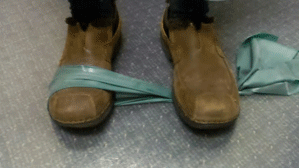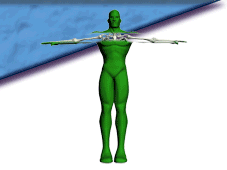The Best Excercies III
WRIST TENDONITIS: Intermittent Compression For this exercise you will need a common household item, something that has "nubs",
like a plastic hair brush or a plastic furniture leg carpet-saver support. Place the nubs on
the area of wrist pain and apply pressure. Hold about one minute. During this time you
should feel some relief or, at least, a vague improvement. The only discomfort should
be a good one, otherwise, reduce the pressure. Now add more pressure to your tolerance
as you begin a small rocking motion of the hair brush. Continue this motion as long as
it feels good. Return to this therapy multiple times daily. If it is feasible allow the hair
brush to remain on the area for a prolonged time by using an elastic bandage wrapped
around the brush and the wrist to apply continuous pressure as long as it feels helpful.
If you are performing the technique correctly you should see the imprint of the nubs on
your skin when you remove the brush. Be careful not to puncture.
For this exercise you will need a common household item, something that has "nubs",
like a plastic hair brush or a plastic furniture leg carpet-saver support. Place the nubs on
the area of wrist pain and apply pressure. Hold about one minute. During this time you
should feel some relief or, at least, a vague improvement. The only discomfort should
be a good one, otherwise, reduce the pressure. Now add more pressure to your tolerance
as you begin a small rocking motion of the hair brush. Continue this motion as long as
it feels good. Return to this therapy multiple times daily. If it is feasible allow the hair
brush to remain on the area for a prolonged time by using an elastic bandage wrapped
around the brush and the wrist to apply continuous pressure as long as it feels helpful.
If you are performing the technique correctly you should see the imprint of the nubs on
your skin when you remove the brush. Be careful not to puncture.Why Nubs?
A major problem with tendonitis is fluid congestion and/or inflammation in the tissues surrounding the tendon. This is why doctors and therapists recommend compression and elevation- compression to improve fluid drainage from the local pain area, and elevation to improve fluid drainage from the entire limb. Tendonitis improves immediately with firm pressure over the area, such as with the use of a brace or elastic wrap. The only problem with this is that after a few minutes this wrap which pushed fluid away is now blocking drainage , adding congestion, and causing further tendon irritation. The solution to this dilemma is INTERMITTENT COMPRESSION- nubs. This technique combines compression with increased and unimpeded flow. Tissue fluid can escape between the nubs at the same time that the local pain area receives compression therapy- the best of both worlds.
ANKLE JOINT STRAIN/SPRAIN - Band Ankle Circles
 Ankle ligament strains and sprains take some time to heal. We would like to speed that
process by applying continuous, active, non-weight-bearing motion in order to remove
fluid congestion and increase blood supply. Let's say the outside of the right ankle is
strained and painful to walk on. Get a two-foot long elastic band and find the midpoint.
Sit down and place that midpoint at the top of the forefoot just above the toes. Wrap
the band around the forefoot and twist the two ends together like a tourniquet. Lay this
twisted tail of the band on the floor pointing toward the non-pain (left) foot. Now, with
that good foot firmly step on the tail and hold it down. Move the painful foot away from
the good one enough to create pull on the band. This is the starting position. Keeping the heel of the right foot on
the floor, make very small circles in a clockwise direction with that forefoot. Do 10 to
20 circles into mild ankle discomfort. Now reverse the direction of the circles to counter-
clockwise and repeat to 10 to 20 circles. Do 3 total sets in each direction.
Ankle ligament strains and sprains take some time to heal. We would like to speed that
process by applying continuous, active, non-weight-bearing motion in order to remove
fluid congestion and increase blood supply. Let's say the outside of the right ankle is
strained and painful to walk on. Get a two-foot long elastic band and find the midpoint.
Sit down and place that midpoint at the top of the forefoot just above the toes. Wrap
the band around the forefoot and twist the two ends together like a tourniquet. Lay this
twisted tail of the band on the floor pointing toward the non-pain (left) foot. Now, with
that good foot firmly step on the tail and hold it down. Move the painful foot away from
the good one enough to create pull on the band. This is the starting position. Keeping the heel of the right foot on
the floor, make very small circles in a clockwise direction with that forefoot. Do 10 to
20 circles into mild ankle discomfort. Now reverse the direction of the circles to counter-
clockwise and repeat to 10 to 20 circles. Do 3 total sets in each direction.The information contained herein is not intended to be a substitute for professional medical advice, diagnosis or treatment in any manner. Always seek the advice of your physician or other qualified health provider with any questions you may have regarding any medical condition.
Return to the Articles Page
Return to the Where's Your Pain? Page



